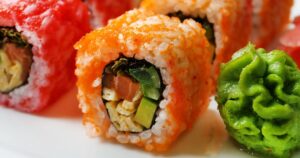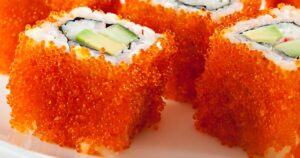If you’ve never tried sushi, you’re in for a treat. It’s a traditional Japanese dish that’s as beautiful to look at as it is delightful to eat.
Sushi is a symphony of flavors and textures bundled into bite-sized pieces. The base of sushi is vinegared rice, which has a tangy flavor. This is often topped or filled with various ingredients, from fresh seafood to crisp vegetables, each adding its unique flavor notes to the mix.
But sushi isn’t just about the taste. It’s also about the experience. The way each piece is carefully crafted, the way it’s traditionally eaten with your hands, the way the flavors explode in your mouth with each bite it’s a culinary journey like no other.
What Is Sushi?
Sushi is a testament to the Japanese art of simplicity and balance. Each piece is a carefully crafted blend of flavors and textures, designed to be enjoyed in a single bite.
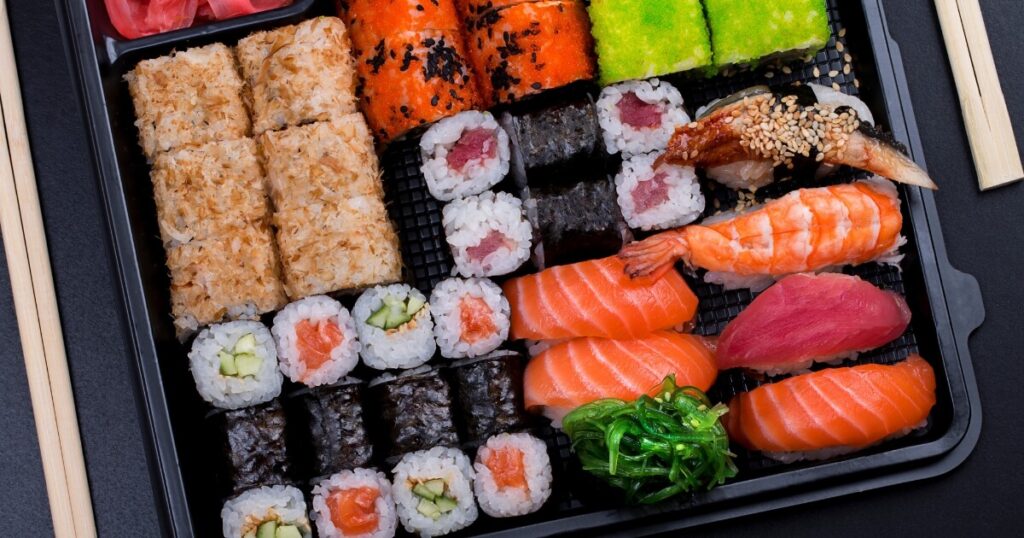
Sushi, in its simplest form, is a dish that combines vinegared rice with a variety of other ingredients. As many believe, “sushi” refers to the rice, not the fish or other toppings. This rice is seasoned with a mix of vinegar, sugar, and salt, creating a tangy and slightly sweet flavor.
The toppings or fillings for sushi can vary widely, but they often include seafood like tuna, salmon, or shrimp. Some sushi also includes vegetables like cucumber or avocado and even tropical fruits in some modern interpretations.
The beauty of sushi lies in its versatility and the endless combinations of flavors and textures it offers.
Types Of Sushi
Sushi comes in many shapes and forms, each with its own unique characteristics. Let’s take a closer look at some of the most common types of sushi you might encounter.
Nigiri

Nigiri is a type of sushi that features a slice of raw fish or seafood placed atop a mound of vinegared rice. The fish is often brushed with a bit of soy sauce and sometimes garnished with a small dab of wasabi. Nigiri showcases the natural flavors and textures of the seafood, making it a favorite among sushi purists.
Maki

Maki, or sushi rolls, are probably what most people picture when they think of sushi. These rolls are made by spreading sushi rice on a sheet of nori (seaweed), adding various fillings, and then rolling it all up using a bamboo mat. The maki roll is then sliced into bite-sized pieces. Maki can be filled with almost anything, from raw fish and vegetables to cooked ingredients and even tropical fruits.
Sashimi
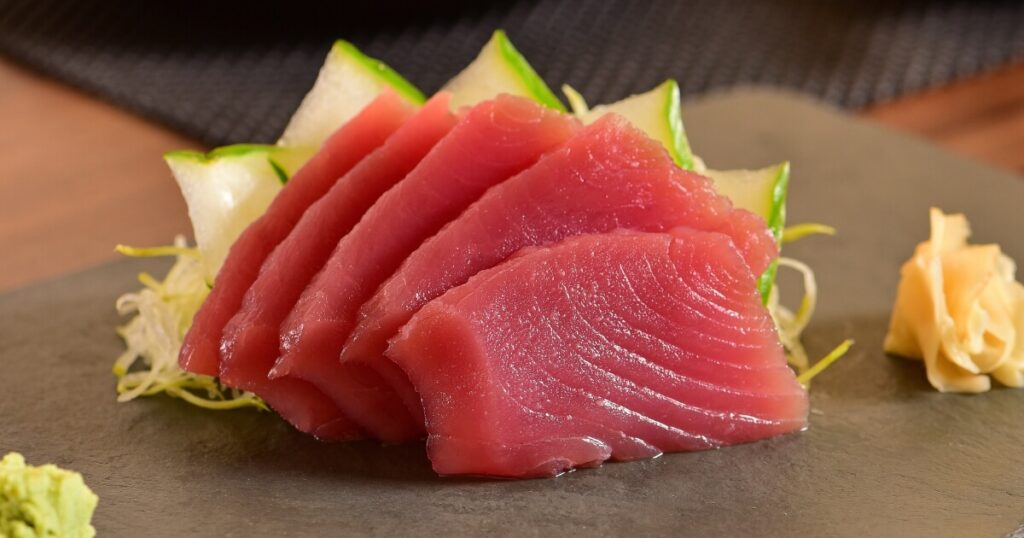
While not technically sushi (since it doesn’t include vinegared rice), sashimi is often served alongside sushi and is worth mentioning. Sashimi is simply thin slices of raw fish or seafood, served without rice. It’s a great way to appreciate high-quality seafood’s pure, fresh flavors.
Chirashi
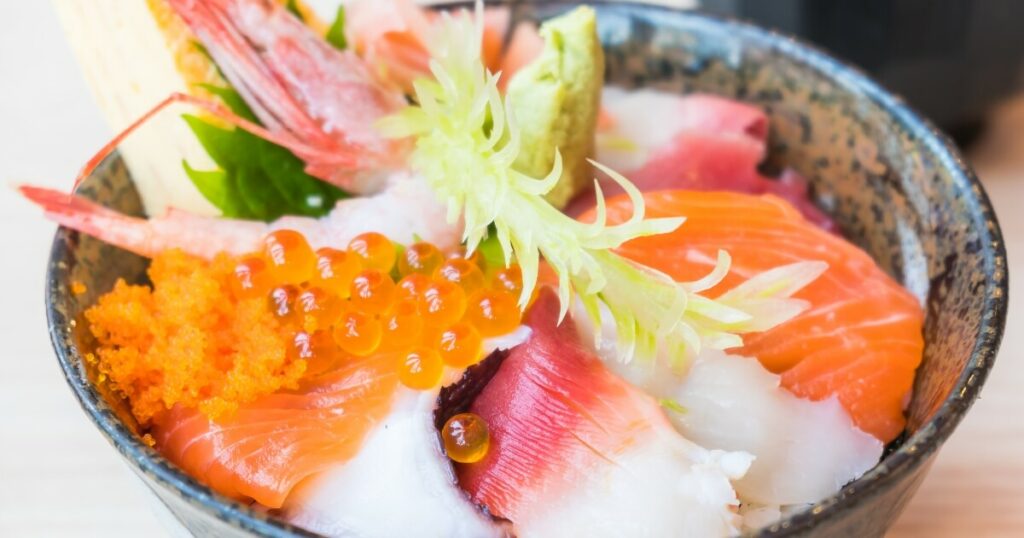
Chirashi, also known as scattered sushi, is a bowl of sushi rice with sashimi and vegetables on top of it. It’s a colorful and delightful dish that offers a bit of everything.
Temaki
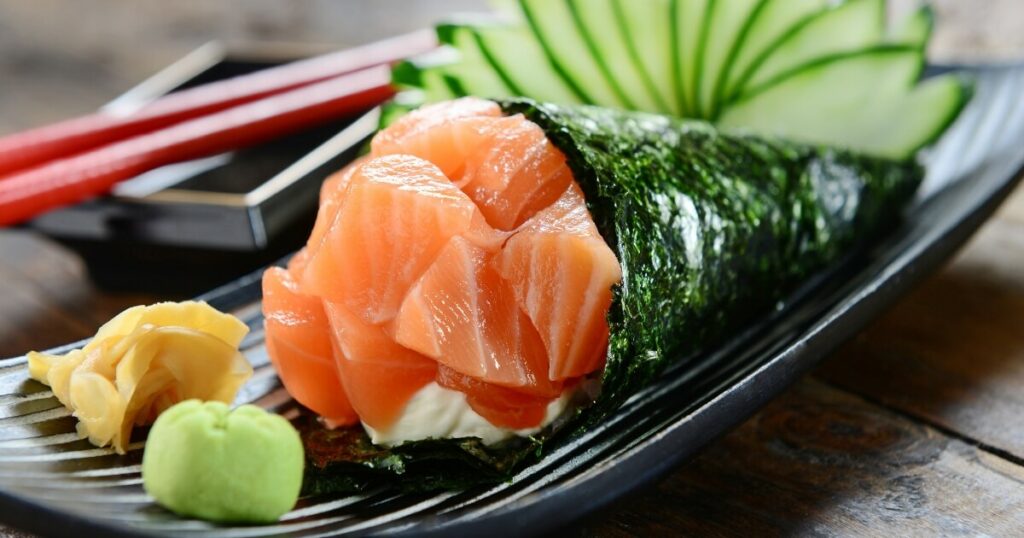
Temaki, or hand rolls, are cone-shaped sushi rolls that are designed to be eaten with your hands. They’re filled with sushi rice and various fillings, then rolled up in a sheet of nori. Temaki is fun to eat and offers a more casual sushi experience.
Each type of sushi offers a unique experience, from the simplicity of nigiri to the variety of chirashi. So, why not try them all and find your favorite?
How To Eat Sushi
Eating sushi is an experience that engages all your senses. Each bite is a treat, from the visual appeal of the beautifully crafted pieces to the delightful flavors and textures. But how do you eat sushi the right way? Let’s find out.
With Your Hands or Chopsticks
Traditionally, sushi was finger food. It was meant to be casual and easy to eat, especially for on-the-go meals. So, feel free to pick up that piece of nigiri or maki roll with your hands. Of course, if you prefer chopsticks, that’s fine too. Just remember to be gentle and avoid squeezing the sushi too hard.
One Bite At A Time
Sushi is supposed to be eaten in one bite. This allows all the flavors and textures to mingle in your mouth, creating a harmonious taste experience. If the piece is too big to eat in one bite, it’s okay to take two bites, but try to finish it without putting it back on the plate.
The Soy Sauce Dip
When dipping sushi in soy sauce, it’s customary to dip the fish side, not the rice side. This prevents the rice from soaking up too much sauce and overpowering the delicate flavors of the fish. Also, remember that a little soy sauce goes a long way.
The Wasabi and Pickled Ginger
Wasabi and pickled ginger are common accompaniments to sushi. Wasabi adds a spicy kick that can enhance the flavor of the fish. However, some sushi chefs may already add wasabi between the fish and the rice, so you might not need extra. The pickled ginger, on the other hand, is meant to cleanse your palate between different types of sushi.
Savor The Experience
Most importantly, take your time and savor each bite. Appreciate the craftsmanship that went into each piece of sushi and the fresh, high-quality ingredients. Eating sushi is not just about filling your stomach but also about appreciating the art of sushi making.
So, whether you’re at a high-end sushi restaurant or enjoying homemade sushi, remember these tips and make the most of your sushi experience.
Sushi FAQs
What is the right way of adding soy sauce to your sushi?
When adding soy sauce to your sushi, it’s best to dip the fish side into the sauce rather than the rice side. This prevents the rice from soaking up too much sauce and becoming soggy. Also, a little soy sauce goes a long way, so a light dip is usually enough.
Does vegetarian or vegan sushi exist?
Absolutely! There are many types of vegetarian and vegan sushi options available. These can include sushi made with vegetables, pickled ingredients, tofu, and even some types of fruit. So, whether you’re a vegetarian, a vegan, or just looking to try something new, there’s a sushi option out there for you.
What is the difference between sushi and sashimi?
While both sushi and sashimi involve raw fish, the main difference lies in the rice. Sushi includes vinegared rice and can be topped with various ingredients, while sashimi is simply thin slices of raw fish served without rice.
Are you suppose to use chopsticks or your hands when eating sushi?
Both ways are acceptable! Traditionally, sushi was a finger food, so eating it with your hands is perfectly fine. However, if you prefer using chopsticks, that’s okay too. Just remember to handle the sushi gently to keep it from falling apart.
What are the differences between Japanese and American Sushi?
Japanese sushi tends to focus on the quality and freshness of the fish with minimal additional ingredients. American sushi, on the other hand, often includes a variety of ingredients and sauces and may even be deep-fried. The California roll, for example, is an American invention.
Why is pickled ginger served with sushi?
Pickled ginger, or gari, is often served with sushi to cleanse the palate between different pieces. This allows you to fully appreciate the unique flavors of each type of sushi.
How often do Japanese people eat sushi?
While sushi is a popular dish in Japan, it’s often considered a special-occasion meal rather than everyday fare. However, casual types of sushi, like maki rolls or chirashi, are eaten more frequently.
My Tasty Thoughts
Whether you’re a seafood lover or a vegetarian, a type of sushi is just right for you.
One of the joys of eating sushi is the element of surprise. Each piece can offer a different taste experience, from the rich, buttery flavor of a tuna nigiri to the refreshing crunch of a cucumber maki roll.
And let’s not forget the delightful contrast between the warm wasabi and the cool pickled ginger. It’s these unexpected combinations that make sushi such a delight to eat.
Finally, trying sushi can be a great way to step out of your comfort zone and try something new. It’s a chance to explore Japanese cuisine, appreciates the skill and craftsmanship that goes into each piece of sushi, and discover new flavors and textures you might not encounter in your everyday meals.
